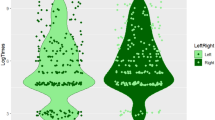Abstract
Colour discrimination performance of honeybees was examined by training bees to a two-coloured disc presented on a vertical plane. Access to the food reward was through the centre of the disc. In one experiment, the upper half of the disc was yellow, and the lower half blue. In another experiment, this was vice versa. In either case, the learned disc was tested against each of a series of ten discs whose colour differed in either the upper or the lower half. A comparison between the results obtained in the two experiments reveals that colour discrimination is significantly better in the lower half of the frontal eye region than it is in the upper half. The results, similar to earlier results obtained in pattern discrimination tasks, cannot be explained by peripheral eye-region-specific specializations. It is proposed that the functional significance of the lower frontal visual field is based on more central neural mechanisms that might constitute an adaptation to the forager's natural needs.
Similar content being viewed by others
Author information
Authors and Affiliations
Additional information
Accepted: 2 November 1998
Rights and permissions
About this article
Cite this article
Lehrer, M. Dorsoventral asymmetry of colour discrimination in bees. J Comp Physiol A 184, 195–206 (1999). https://doi.org/10.1007/s003590050318
Issue Date:
DOI: https://doi.org/10.1007/s003590050318




